
Beaux-Arts architecture was the academic architectural style taught at the École des Beaux-Arts in Paris, particularly from the 1830s to the end of the 19th century. It drew upon the principles of French neoclassicism, but also incorporated Renaissance and Baroque elements, and used modern materials, such as iron and glass. It was an important style in France until the end of the 19th century.

Retiro is a barrio or neighborhood in Buenos Aires, Argentina. Located in the northeast end of the city, Retiro is bordered on the south by the Puerto Madero and San Nicolás, and on the west by the Recoleta.

San Martín Palace is located facing Plaza San Martín in the Retiro neighbourhood of Buenos Aires, Argentina and serves as the Ceremonial Headquarters for the Ministry of Foreign Relations.
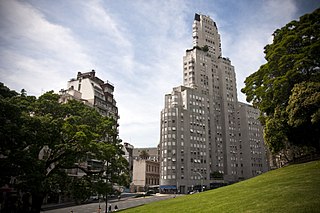
The Kavanagh Building is a famed skyscraper in Retiro, Buenos Aires, Argentina. Designed in 1934 by architects Gregorio Sánchez, Ernesto Lagos and Luis María de la Torre, it is considered a pinnacle of modernist architecture. At the time of its inauguration in 1936, the Kavanagh was the tallest building in Latin America, as well as the tallest building in the world with a reinforced concrete structure.

Banco de la Nación Argentina is a national bank in Argentina, and the largest in the country's banking sector.

The architecture of Argentina can be said to start at the beginning of the Spanish colonisation, though it was in the 18th century that the cities of the country reached their splendour. Cities like Córdoba, Salta, Mendoza, and also Buenos Aires conserved most their historical Spanish colonial architecture in spite of their urban growth.
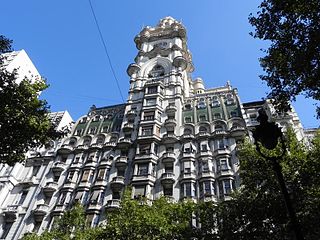
Palacio Barolo is a landmark office building, located at 1370 Avenida de Mayo, in the neighborhood of Montserrat, Buenos Aires, Argentina. It stood as Buenos Aires' tallest building for more than a decade until the construction of the Kavanagh Building in 1936. Its twin brother, Palacio Salvo, is a building designed and erected in Eclectic style, built by the same architect in Montevideo.
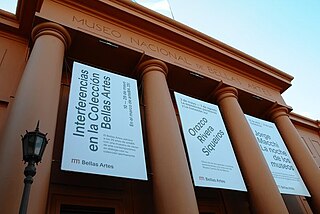
The Museo Nacional de Bellas Artes is an Argentine art museum in Buenos Aires, located in the Recoleta section of the city. The Museum inaugurated a branch in Neuquén in 2004. The museum hosts works by Goya, Rembrandt, Van Gogh, Rodin, Manet and Chagall among other artists.

Avenida Figueroa Alcorta is a major thoroughfare in Buenos Aires, Argentina, with a length of over 7 km (4.3 mi) along the city's northside.

Córdoba Avenue is one of the principal thoroughfares in Buenos Aires, Argentina.

Callao Avenue is one of the principal thoroughfares in Buenos Aires, Argentina.

The Palacio Duhau - Park Hyatt Buenos Aires is a five star establishment located in the city's Recoleta section.
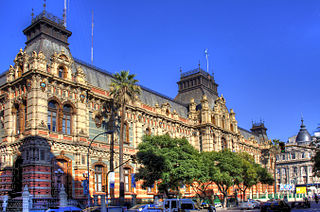
The Palace of Running Waters is an architecturally significant water pumping station in Buenos Aires, Argentina and the former headquarters of Obras Sanitarias de la Nación. It is currently administered by Agua y Saneamientos Argentinos (AySA).

Sofitel Buenos Aires is a five star hotel in the Retiro section of Buenos Aires.
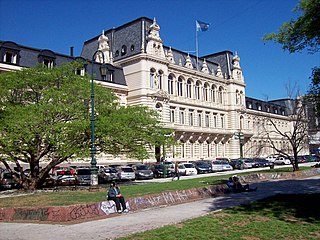
The Sarmiento Palace, commonly known as the "Pizzurno Palace", is an architectural landmark in the Recoleta section of Buenos Aires and the location of the Argentine Ministry of Education.

The Buenos Aires House of Culture is an architectural landmark in the Montserrat section of the Argentine capital.

Avenida Leandro N. Alem is one of the principal thoroughfares in Buenos Aires, Argentina, and a commercial nerve center of the city's San Nicolás and Retiro districts. It joins Avenida del Libertador and Avenida Paseo Colón, its northern and southern continuation respectively.

Harrods Buenos Aires is a historic commercial building in Buenos Aires, Argentina, formerly a branch of Harrods of London.

The Bosch Palace is an architecturally significant residence in the Palermo section of Buenos Aires, Argentina.
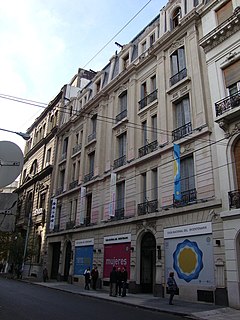
The Casa Nacional del Bicentenario is a cultural center and museum located in the Recoleta section of Buenos Aires, Argentina.























